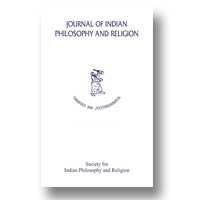|
4.
|
Journal of Indian Philosophy and Religion:
Volume >
15
Kevin M. Brien
Humanistic Marxism and Buddhism:
Complementaries
abstract |
view |
rights & permissions
| cited by
In this paper I argue that Buddhism and humanistic-Marxism have much in common, and that they really are quite complementary in many ways. Early on I cite the Dalai Lama and some remarks he makes in relation to Buddhism and Marxism—remarks that seem not to make a distinction between orthodox-Marxism and humanistic-Marxism. I then go on to give a brief sketch of some of the central aspects of humanistic-Marxism; and in doing 50 I draw from a number of well-known Eastern European philo-sophers. Among other things, I focus on the relation between the early and late Marx, "praxis", 'free conscious activity", historical materialism, the spiritual dimension in Marx and its role in social transformations, etc. After a brief indication of the Buddhist "four noble truths", I bring out that both Marx and Buddha are deeply concerned about human suffering; but that there is an important difference in emphasis with respect to the external and internal Factors associated with human suffering. I go on to bring out that both perspectives agree that there is no creator God, or eternal soul; and that both perspectives see reality as process in character. For each perspective this means that things are what they are by virtue of the dynamic interrelations they have with other things. whether directly and indirectly. I bring out that both perspectives begin their analysis of the human condition with the given situation in which human beings find themselves, and that both perspectives see human beings as the makers of themselves, but that they do so in somewhat different ways. Also both perspectives see human beings as making themselves on the basis of the ways they have made themselves in the past, but as doing so in ways that are not fatalistic. In this connection I compare the Buddhist view of karma, and an overlapping view of social karma in Marx. Also I discuss Buddhism ancj Marxism with respect to the notion of the ego-self, and the question of whether there are many different forms of the ego-self; and if so, how such different forms might come about, and what this would mean in relation to the Buddhist notion of ''samsara". Finally, ! point to a way that humanistic-Marxism could consistently acknowledge a possible transcendence of the ego-self. In passing I point out that the notion of "unalienated spirituality" in Marx has much in common with the Buddhist notion of "enlightenment".
|
|
|
6.
|
Journal of Indian Philosophy and Religion:
Volume >
15
Melanie K. Johnson-Moxley
"Our Jane" and Gitā-yoga:
Non-Gender Exclusiveness of the Bhagavad-Gitā
abstract |
view |
rights & permissions
| cited by
Suppose that the protagonist of the Bhagavad-Gitā had been a woman. Would Krishna's message to her have been the same as it was to the morally tormented warrior Arjuna? Could it have been, without violating the essential intentions of this work? Consider the historical case of Lakşmibai, the Rani of Jhansi, a rare and legendary female warrior who lived, fought and died in nineteenth-century Colonial India. For the sake of argument, one could imagine her in Arjuna's place and ask: what if she had experienced Arjuna's moment of moral doubt (and spiritual need) before taking to the battlefield? Would the answers for her be the same as they were for Arjuna? Or to put it another way: is there a gender-exclusiveness in the message of the Gitā?Upon close examination, this does not appear to be the case. The three-fold discipline described by Krishna, or Gitā-yoga" to borrow a phrase from Bina Gupta, is multi-faceted precisely because human beings are different from each other as individuals; yet it is capable of being articulated as a universalizable discipline because human beings are fundamentally the same with respect to their humanity and mortality, irrespective of gender, occupation or circumstances. Anyone can pursue Gitā-yoga in order to act morally and realize spiritual satisfaction, albeit the particulars of that pursuit are expected to vary according to individual capacity, character and disposition. The Gitā does not at any point, however, draw distinctions between the duties, virtues or spiritual capacities of persons on the basis of gender. Lakşmibai serves as an excellent example of a woman who could potentially realize all three aspects of Gitā-yoga, further belying any temptation to interpret Krishna's message as surreptitiously gender-exclusive and thus strengthening a case for its applicability as a moral philosophy for a contemporary world.
|
|





